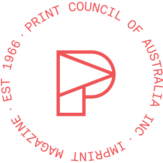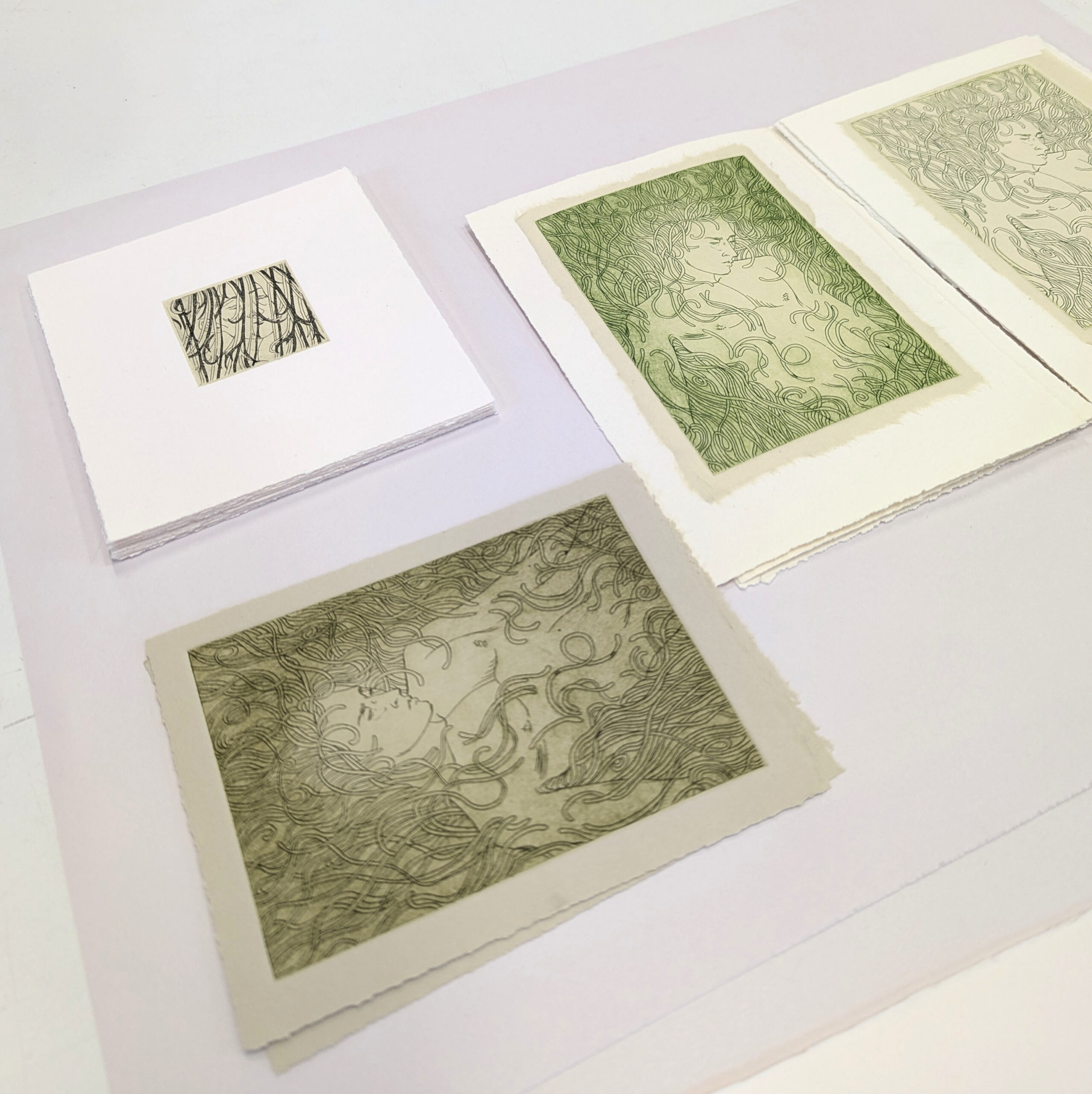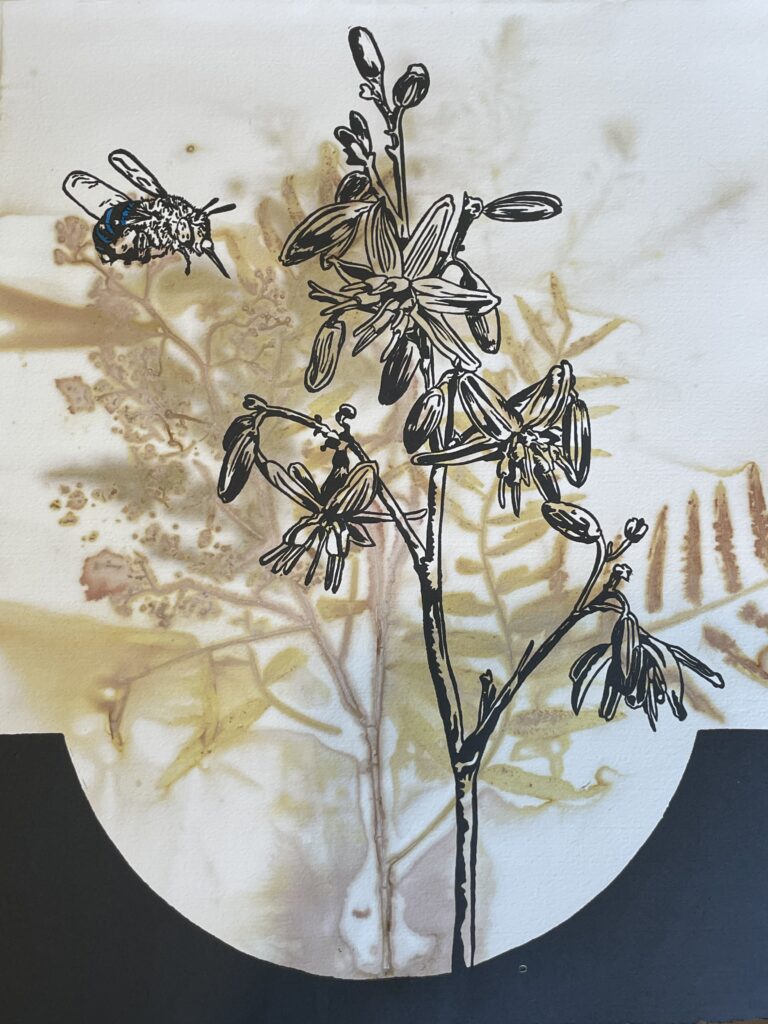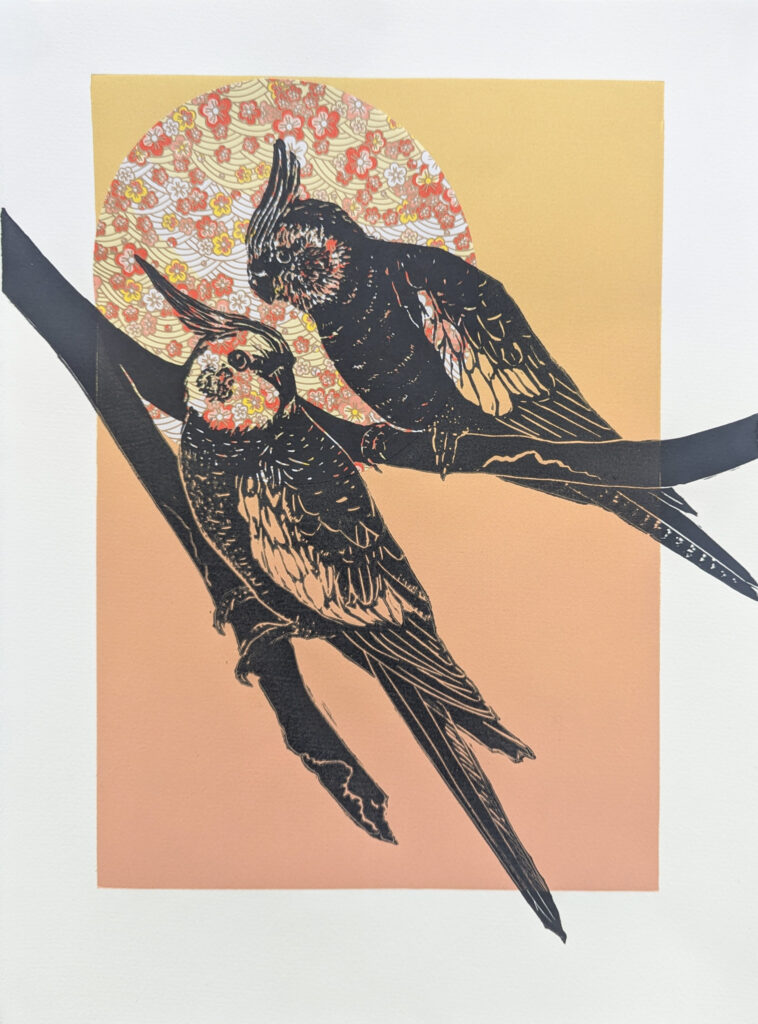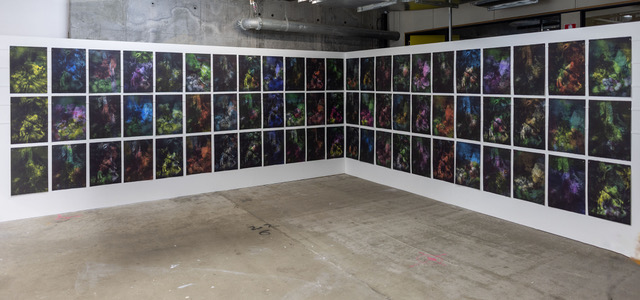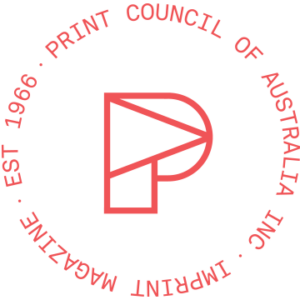Top:
Amy Grover’s work in progress at Firestation Print Studio. Photography: Liz McDowell
Below:
Group meeting at Firestation Print Studio. Photography: Fiona Davey
Screenprint emulsion on copper plate prior to etching, plate by Lucas Jennings. Photography: Liz McDowell
Odin Strbac Low printing at Firestation Print Studio. Photography: Liz McDowell
All images copyright and courtesy of the artists.
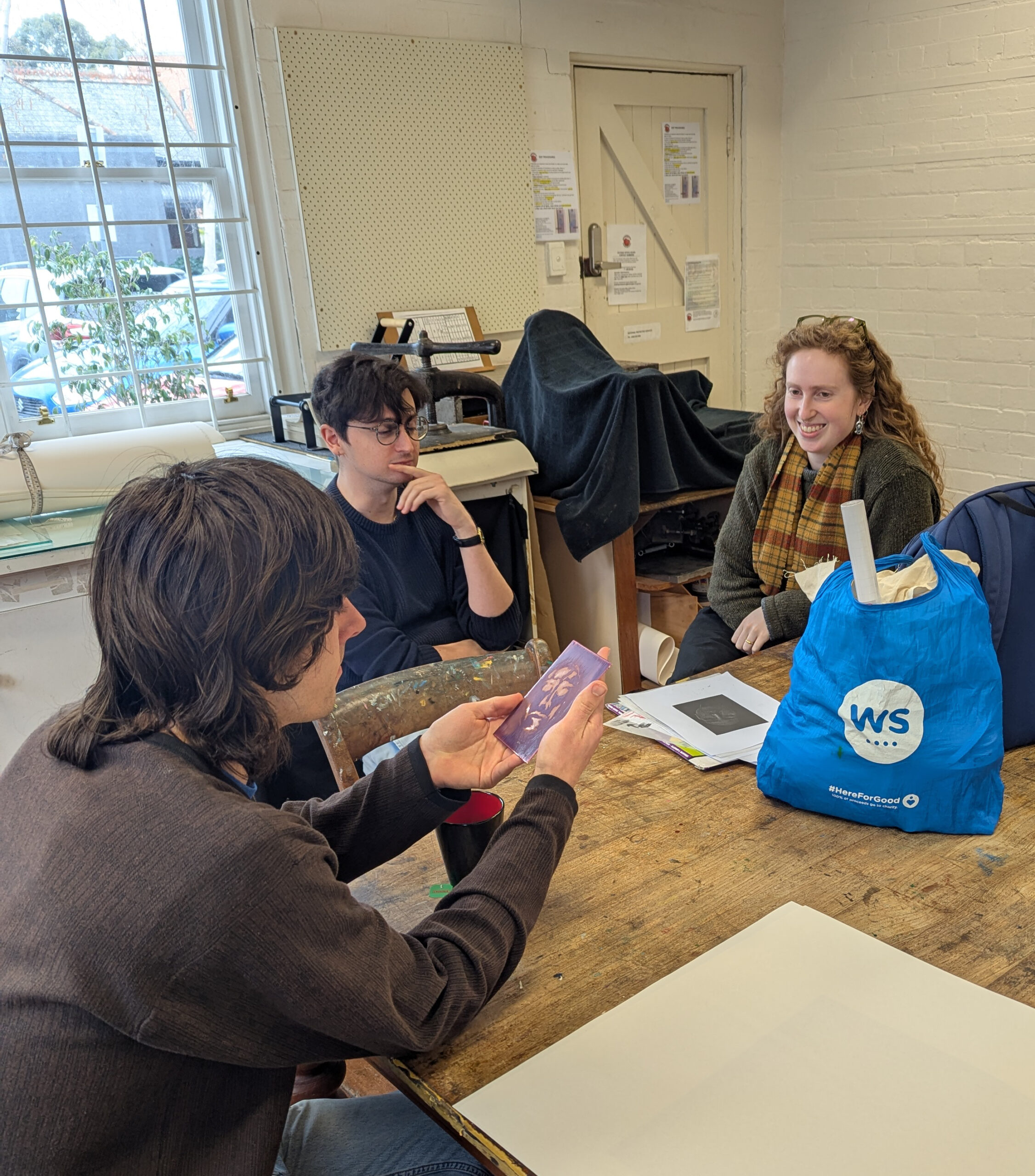
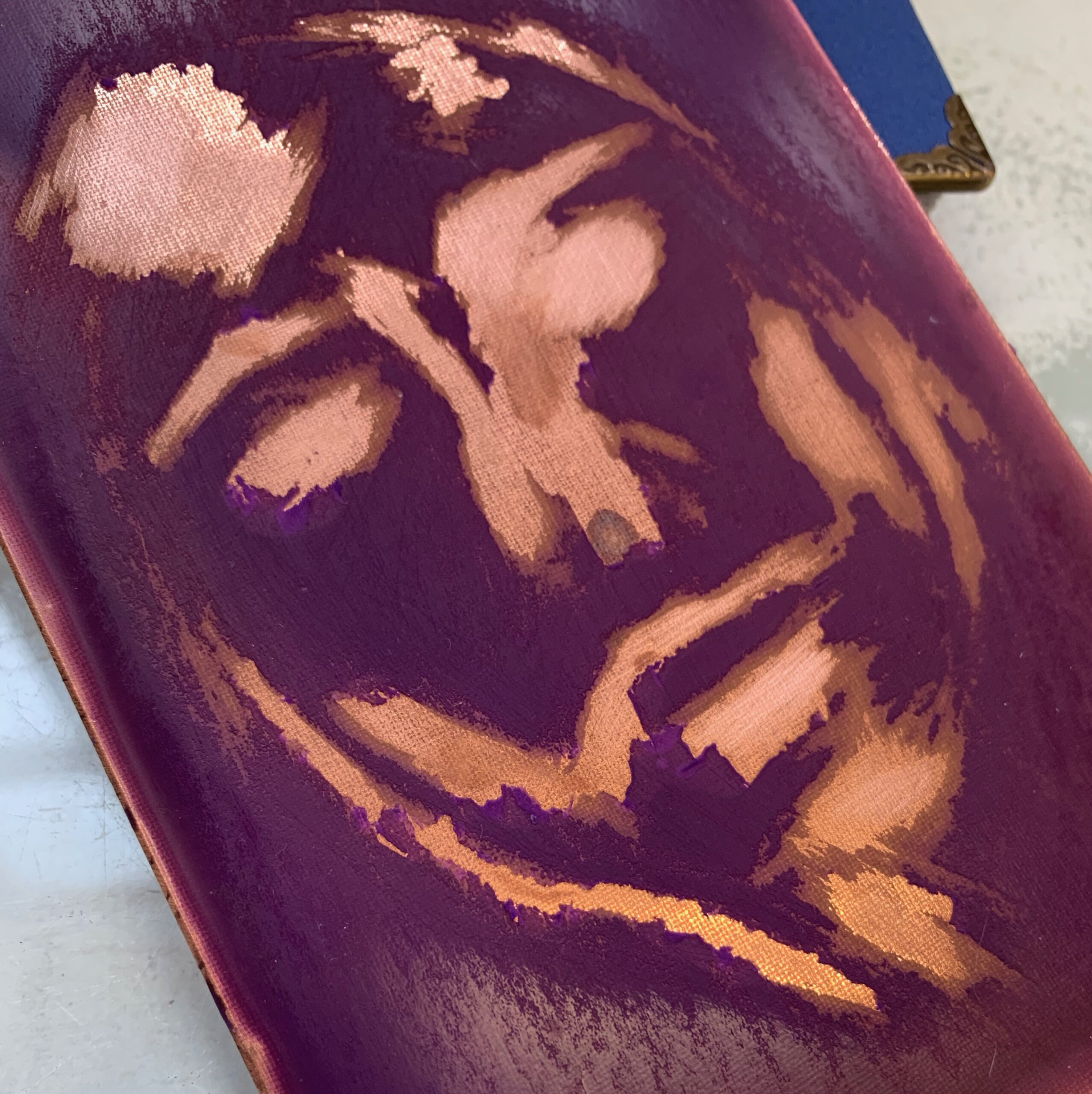
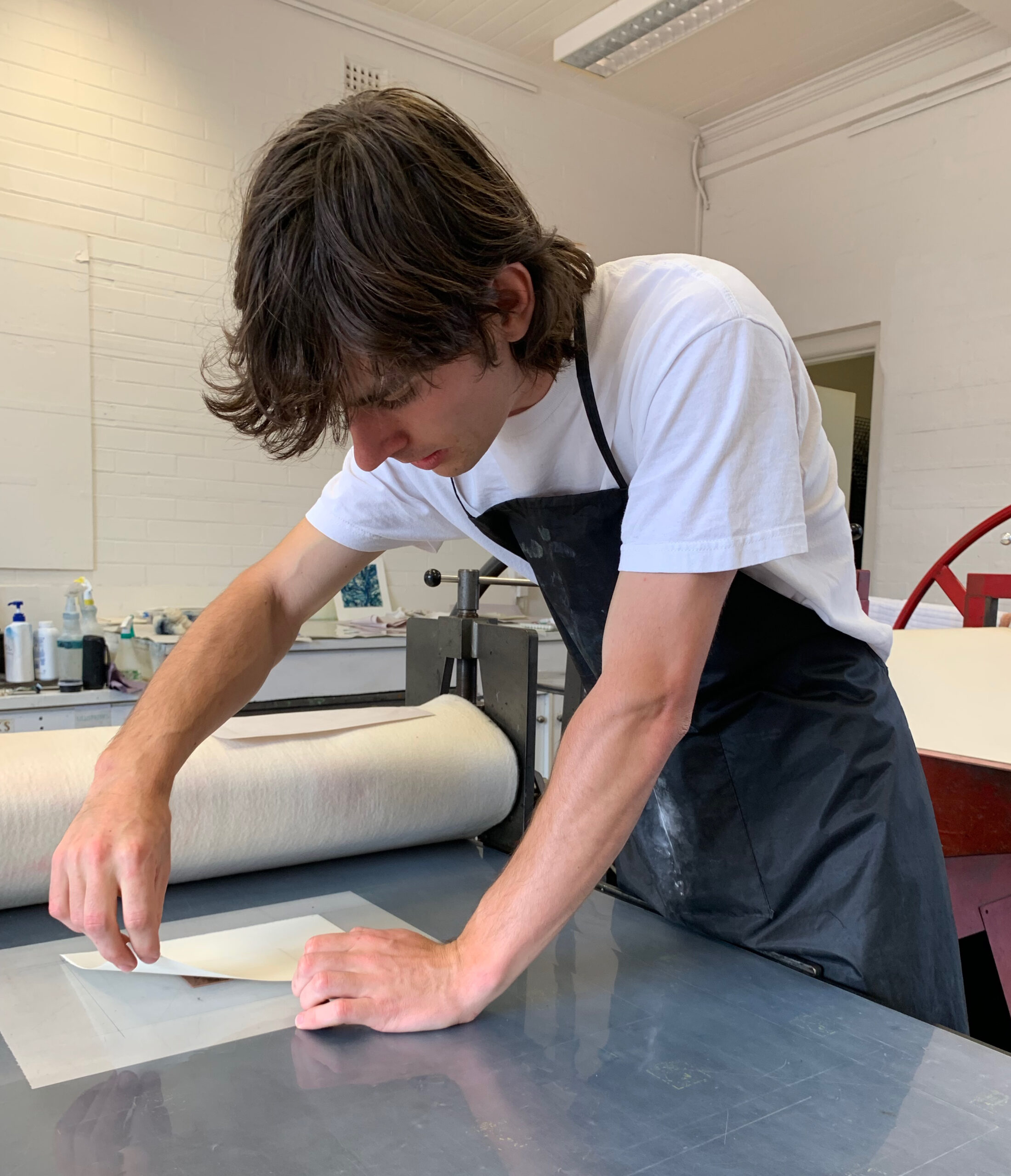
Q: What were some of the foundation ideas for this exhibition project?
(Odin): As a group, we were drawn to the idea of contingency, both as a condition of existence and as a central aspect of printmaking. Print processes often hinge on what is unpredictable so each of us explored this in our own way, allowing contingency to guide the formation of works and to shape the questions our practices ask of material, image, and form.
(Amy): Drawing on what Odin has spoken on, with contingency as both a condition of existence and of print, speaking to my own practice for this exhibition that foundation of contingency of existence has been central to my development of imagery. An imagery based on complicated and diverse conceptions of humanness and being.
(Lucas): Throughout the development of this exhibition, I became enthralled with the concept of contingency and how it might apply to the themes of inheritance and lineage that I commonly dwell on. These are very sequence-oriented topics, where the current iteration of the sequence is entirely contingent on the previous iteration and the circumstances that form its successor. For instance, my presence as an artist in this very exhibition is contingent on the ever-fading existence of my late father and the many positive and negative experiences that moulded my character. Investigating these topics led me organically to the repetitive aesthetics of chains, fabric and DNA strands, the things that bind us.
Q: How did the artwork selection take place?
(Amy): My process of selection has been rather uncomplicated. Rather than pulling together works from the past I’ve made the chosen prints to our shared exhibition proposal. Their selection has been a process of response rather than selecting pre-existing works to fit a brief. In some cases, selection has included progressive editions of certain prints as I wanted to express some of the conversations I had with the plate/image when working towards a final print.
(Lucas): Typically, my artistic workflow involves working towards a strict, predetermined end goal and then bemoaning my existence when the abstract ideal was not met. This exhibition demanded that I loosen my creative grip, experiment, and surrender to the unpredictable whims of the printmaking process. You can witness this in my series of abstract portraits, made using screen print emulsion on copper plates as a resist for etching. The unpredictable nature of the material left much of the final image out of my hands.
(Odin): For my own contribution, the selection followed the progression of the series. Some works emerged as turning points, when a new material or technique opened unexpected possibilities. Others were produced to test those discoveries, to see whether they could be repeated or extended. Together, they form a sequence rather than a hierarchy, charting the development of an idea through practice.
Q: How does the exhibition manifest – what do visitors experience?
(Amy): For me, across making work for this exhibition I’ve been consistently informed by the particular quote by Rainer Maria Rilke that we chose as a group to base our proposal on. He speaks of embracing the broadness of existence and the unpredictability of life, and I hope that visitors experience my personal interpretation of that quote, to be drawn into these figures, where humanness is strange and intertwined with plant matter. While not necessarily immediately unpredictable, throughout working with these plates to create finalised images, I found myself in conversation with the plates themselves and the imagery upon them. They transformed in ways I hadn’t planned when I transferred them from original sketch to plate or when I pulled them off the press with adjustments to ink, inking technique and paper choices. I hope visitors are equally drawn into the exploratory, broad and unpredictable experience of making these prints.
(Odin): Visitors encounter an exhibition shaped by both individual practices and shared concerns. Each body of work stands on its own terms, yet collectively the exhibition reflects on how contingency operates in making: the relationship between control and chance, permanence and instability. In my own works, the repetition of a horizon motif provides a visual anchor, while the material combinations invite a slower, more tactile kind of looking.
(Lucas): While my compatriots and I work in quite disparate aesthetics, I feel there is a deeper connective tissue between our methodologies and a shared interest in history that aligns with our personal passions. There is an introspective contemplation present that one could view as optimistic or entirely morose. I, myself, am constantly staggering between the two feelings. Ultimately, I think how a visitor experiences this exhibition will be entirely contingent on their mindset at the time of viewing.
Q: What are some of the key works and what subject matter do they deal with?
(Lucas): My large soft sculpture piece is an evolution of my prior experiments in making rag dolls from printed materials. The project was initially conceived as a dangling chain of conjoined rag dolls, each one holding onto the ankles of the ankles of the one beneath it. As I progressed my research, the piece morphed into an abstract hybrid of a paper doll chain and a double helix DNA structure. The printed chain pattern that adorns the work is littered with sporadic breaks in the chain links. Contextualising this with the theme of lineage evokes DNA deterioration, a weak link in the chain, a dead-end to a family tree, a sequence changing, perhaps for the worse.
(Amy): The particular works of ‘ēce’ and ‘fen-friþu’ are probably the closest to me as an artist. Representing both a development of my skill as a printmaker and artist and how that arises in my continued exploration of the subject matter of the diversity of feeling and expression held within us as people. They represent a comfort to be found in what may be deemed “strange” or “inhuman” of the broadness of existence. The figures and foliate elements are extensions of one another, rather than separate entities. Both are titled with Old-English words; ‘ēce’ meaning ‘perpetual or eternal’ and ‘fen-friþu’ meaning ‘fen- refuge or wetland asylum’. These words are chosen both for the more immediate inspiration of the medieval foliate head, but also for their connotations of comfort to be found in human strangeness and diverse expression and the perpetuity of this sensation across time.
(Odin): Within my series, no single work stands apart as key. Each is necessary, either as an initial experiment or as a continuation of a discovery. Together they revolve around the motif of the horizon: a pared-down reference to landscape that is less about depicting place than about marking orientation and perception. While my palette is influenced by the Australian landscape, the horizons remain open, suggesting not a specific location but a condition of looking and being.
Q: What is it about the printmaking experience that you most appreciate?
(Odin): What I value in printmaking is its quiet insistence on material encounter. Printmaking teaches that each impression is both unique and repeatable, that chance and control are always in negotiation. It is in this respect, where the process itself becomes a way of thinking, that my work takes shape.
(Amy): I’ve really come to enjoy the continual process of transformation from drawing to plate to paper, every iteration is slightly different, and each print exemplifies a different experience through subtle changes in paper type and ink colour. It offers the opportunity to experiment with the image and its subsequent readings in ways that are not possible through other mediums. Likewise working across print mediums always offers opportunity for learning and growth that I really enjoy, there’s so many opportunities to alter, grow and adapt practice.
(Lucas): I adore the strong community that is intrinsic to printmaking as an artform and trade. It is a prevailing joy to find myself surrounded by such a diverse and welcoming cohort, all with their own niche areas of expertise to admire. Talk to any printmaker about their practice, and no matter how fashionable their external façade is, you’ll find that you are indeed talking to a tremendous nerd.
—
Time and again, by Lucas Jennings, Odin Strbac Low and Amy Grover, is at PCA Gallery, Studio 2 Guild, 152 Sturt Street Southbank, 13-31 October. Opening event 16 October 5-7pm
—
Join the PCA and become a member. You’ll get the fine-art quarterly print magazine Imprint, free promotion of your exhibitions, discounts on art materials and a range of other exclusive benefits.
